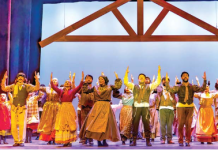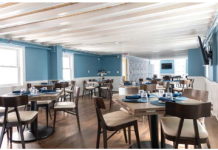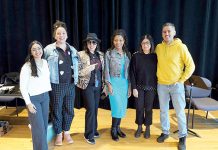“The arts are the very heartbeat of humanity.
They are the bones of what might, one day
become a unifying world culture.”
-Seward Johnson
By Linda McK Stewart
You step from the shade of a copse of evergreens into a sunlit grassy clearing. And there they are: two massive bovines, reclining at their ease, the afternoon light glinting off their bronze flanks. Something about that duo of contrasts…the dappled dark of the evergreens versus the full-throttle glare of the sunshine; the metallic gleam of the bulky sculpture viewed against a sweep of manicured green lawn …for just a nanosecond your sense of reality misfires. The antidote: trailing fingertips against the cool, smooth hardness of the sculpture even as your feet sink ever so gently into the turf.
It can evoke any reaction from delight to bewilderment, from curiosity to awe. It can be witty, cerebral, inspirational, symbolic, or even absurd.
It’s exactly that sense of the unexpected that delights and astounds, which makes a visit to the Grounds for Sculpture (GFS) in Hamilton, just outside Princeton, such a heady experience. Peter Woytuk’s bovine masterpiece, entitled simply “Bulls,” is only one of the 250 pieces of sculpture, artfully placed around the 40 acres of GFS. Some pieces are tucked away in woodland bowers, others sheltered in the lea of a hillside carpeted in wildflowers. A path borders a pond, then swerves and you’re face to face with a sculptured group of picnicking merrymakers, taking their ease on a blanket, their wicker basket spilling its contents around them. You’re caught off balance. Why does the scene ring with faint familiarity? Until you realize…of course! It’s Manet’s Déjeuner sur l’Herbe, magically made three-dimensional. The sculptor, and not incidentally founder of GFS, Seward Johnson, now 81 years old, has perfected the art of creating life-size figures, in everyday settings, some imaginary, others like this one, lifted, detail-perfect from the works of 19th century French Impressionists. In stylistic contrast to the creations of Woytuk and Johnson is the work of Steve Tobin whose massive iron abstract creations are the feature exhibit in the newly opened, 7-acre Meadow on the south side of GFS. It’s soon apparent to even the most casual of visitors, that the Grounds For Sculpture embraces all aspects of contemporary sculpture be it representational, monumental or abstract. It can evoke any reaction from delight to bewilderment, from curiosity to awe. It can be witty, cerebral, inspirational, symbolic, or even absurd.
Only as recently as the late 1980s these same 40 acres were a sorry eyesore. Once the site of the New Jersey State Fair, then a racetrack, the area, pancake flat, was strewn with industrial waste and dilapidated buildings. Johnson bought the land and a master landscaping design began to unfold. Flat lands were elevated into berms. Trees, 2,000 of them, many rare botanical specimens, were planted. More than 40 species of ornamental grasses, tens of thousands of shrubs, tens of thousands of rose bushes all were brought in and strategically located so as to assure both open vistas and secluded retreats. Water in the form of ponds, rivulets, waterfalls and spillways was an integral part of the overall design.

The unique result is a veritable wasteland transformed into an oasis of kinetic experiences. Call it a park, arboretum, garden, museum or landscape; it’s a place where art and nature exist in a rare harmony, valid for all ages, all persuasions. That miracle of transformation stems from the visionary dedication of Seward Johnson. His objective was to provide a haven for emerging artists and to invite the public to view their art in a hospitable setting. It’s not by happenstance that no exhibits are cordoned off. Visitors are (with only a few exceptions) invited to touch or rub hands across the granite, the iron, marble, steel or bronze surfaces. No climbing please. Ground level plaques identify each piece and give the name of the artist.
In addition to what is immediately apparent, GFS maintains an artist-in-residence program by which artists from all over the world are accommodated in working studios. They often give talks to invited groups. On occasion they serve as guides, discussing their own work and the work of fellow artists. Periodically workshops are held, some for children, some for adults, accessible by subscription and directed to everyone from rank beginners to long-time painters, sculptors and craftsmen.
For casual refreshments there’s the self-service Peacock Café. On weekends ice cream and sodas as well as beer and wine are available at The Gazebo, located next to the lotus pond. For the high-minded would-be diner there is Rat’s Restaurant its (unfortunate!) name taken from that childhood classic favorite Wind in the Willows. There the ambiance is French provincial. The view is of a willow-fringed pond, ducks on parade, easily recognizable as a copy of the pond at Giverny out side Paris, where Claude Monet lived and painted. The service is genteelly superb. The menu is imaginative and the preparation and presentation is faultless plus delicious. Wine by the glass or by the bottle. Reservations essential. Adjoining Rat’s is a gift shop that eschews the ticky tacky in favor of handsome crockery, silverware and small works of art. The gift books are few in number but exceedingly handsome.
GFS is open all year round. The grounds are artfully lit over the holidays making an after-dark tour of the grounds a special delight.
IF YOU GO: For driving directions and more detailed information see www.groundsforsculpture.org or (609) 586-0616.














